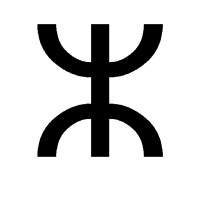 The letter yaz (pronounced /z/) is one of the thirty-three letters of the modern Neo-Tifinagh alphabet, a so-called abjad script currently used to write in the Amazigh (Berber) languages. The script was only introduced late into the 20th century, when Amazigh ethnic nationalism and awareness increasingly rose to prominence across Northern Africa. Faced with suppression and prosecution in countries with large Berber communities, like Morocco, Algeria and Libya, the Neo-Tifinagh script became an extremely popular tool within the Amazigh rights movement, the alphabet effectively expressing and representing the identity of a whole people.
The letter yaz (pronounced /z/) is one of the thirty-three letters of the modern Neo-Tifinagh alphabet, a so-called abjad script currently used to write in the Amazigh (Berber) languages. The script was only introduced late into the 20th century, when Amazigh ethnic nationalism and awareness increasingly rose to prominence across Northern Africa. Faced with suppression and prosecution in countries with large Berber communities, like Morocco, Algeria and Libya, the Neo-Tifinagh script became an extremely popular tool within the Amazigh rights movement, the alphabet effectively expressing and representing the identity of a whole people.
During the 1960’s, Berber activists, intellectuals, artists and journalists in exile organized themselves as the Berber Academy, a cultural association of mostly Kabyle Berbers based in Paris. They subsequently standardized all the different elements of the ancient Lybico-Berber script attested in Morocco and Algeria and the Tifinagh alphabet used by the Tuareg people, in an attempt to transcribe different Berber languages and revive the old writing system of the region, and with it the spirit of self-empowerment. As a result of these attempts, the introduction of the Neo-Tifinagh alphabet became a fact in the late 1960’s-early 1970’s.
The script became to increasingly break through among the Amazigh people in recent decades because of its symbolic use, although it’s also used for educational purposes in Morocco and Algeria, both in which the Tamazight (Berber) language has been officially recognized. For many, seeing public signs and street names written in indigenous Neo-Tifinagh letters marked a victory and a sign of official acknowledgement.
This Neo-Tifinagh script is based on the historical Lybico-Berber writing system, used from as early as antiquity by speakers of the Libyc languages throughout North Africa and on the Canary Islands. Most surviving texts and sources of that language are archaic funerary inscriptions on stone stelae and hard-to-date rock inscriptions. which, since there are no bilingual Arabic texts found, indicates a general disuse of the alphabet before the arrival of the Arabs. However, the alphabet survived as Tuareg Tifinagh among the Tuareg people well into modern times, used primarily for games and puzzles, short graffiti, rock art and brief messages.
In 1971, the earlier mentioned Berber Academy, proposed an ethnic flag for the Amazigh people. This flag consists of a blue, green and yellow band, respectively representing the sea, the nature and the desert. In it’s center, the Neo-Tifinagh letter yaz is featured in red, representing “freedom” or “free man”, which is in fact the meaning of amazigh (plur. imazighen). Since then, the letter yaz became part of the Amazigh identity, emerging as a symbol in itself detached from the flag. It emerged a lot during the most recent mass protest movement in the Berber-speaking Rif region in northern Morocco, as well as in the yearly independence marches of Kabyle Berbers in Algeria. When Algerian Berber intellectual ‘Ammār Negādī started his Berber calendar in the Amazigh year of 2930, corresponding with the Hijri 1401 or the Gregorian 1980, the symbol yaz was featured as well. In migrant Berber communities, you can find stickers, pendants and posters with the letter, often to make a statement and as a sign of Amazigh identity.
For examples and pictures, please visit this board on my Pinterest.
Omer Sayadi (*1993) is a former student of the Catholic University of Leuven with a special love for the Middle East, North Africa and the Muslim World. After receiving his Master’s degree in Arabic Language and Islamic Studies, his professional work included translation, development and research regarding the region. He occasionally writes on historical and contemporary issues such as Islam in Europe and migration, and started MENA Symbolism as a means of combining everything history, politics, symbolism and society in one place.